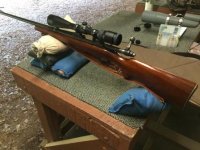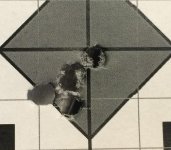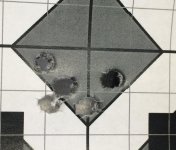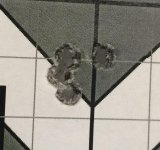elpac3
Member
Just picked up a new favorite rifle, a 1957 vintage Remington 722 in .222 cal. 

Made up some hand loads using Nosler 40 grain Ballistic Tips with 22.5 of H322. Loads shot well - but after reading thought I could do better.
Bought Hornady comparator so I could measure ogive to land seating depth. Went to work and made some loads .040, .030 and .020 off the lands. The .040 off the lands are really close to the OAL in the manual of 2.130. The .040 loads again shot well, same as the week before. Hoping to see things get tighter the .030 loads were a real letdown: mad: as the group opened up. The .020 loads tightened up significantly, producing all rounds touching.
Moving onto the Hornady 50 grain Vmax, again the OAL of 2.130 and 22.5 of H322 produced a load that was .040 off the lands. Shot it and had good results. Made up a batch of .040, .030 and.020 loads and back to the range. Shooting the .040 loads produced and identical target to the one from the week before.

Being anxious to try the .020 load I fired them next and was totally disappointed, having hoped for results similar to the Nosler.
having hoped for results similar to the Nosler.
Not sure what to expect from the .030 loads I was pleasantly surprised when they turned in the best group of the day. Could have been a one hole group had I done my part with a called flyer.
Lesson learned: Even though shapes are similar and seating depths are close, you never really know what each individual gun will like until you test under controlled conditions changing only one variable at a time.

Made up some hand loads using Nosler 40 grain Ballistic Tips with 22.5 of H322. Loads shot well - but after reading thought I could do better.
Bought Hornady comparator so I could measure ogive to land seating depth. Went to work and made some loads .040, .030 and .020 off the lands. The .040 off the lands are really close to the OAL in the manual of 2.130. The .040 loads again shot well, same as the week before. Hoping to see things get tighter the .030 loads were a real letdown: mad: as the group opened up. The .020 loads tightened up significantly, producing all rounds touching.
Moving onto the Hornady 50 grain Vmax, again the OAL of 2.130 and 22.5 of H322 produced a load that was .040 off the lands. Shot it and had good results. Made up a batch of .040, .030 and.020 loads and back to the range. Shooting the .040 loads produced and identical target to the one from the week before.

Being anxious to try the .020 load I fired them next and was totally disappointed,

Not sure what to expect from the .030 loads I was pleasantly surprised when they turned in the best group of the day. Could have been a one hole group had I done my part with a called flyer.

Lesson learned: Even though shapes are similar and seating depths are close, you never really know what each individual gun will like until you test under controlled conditions changing only one variable at a time.
